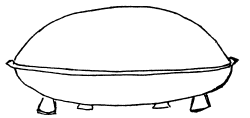
Given the fact that this is a single-witness case (no additional witness was uncovered at a later date) the GEPAN investigation on February 17, 1981 centered on the gathering of additional samples, especially vegetal samples. The witness was heard as well as his wife, and a brief reconstruction of the sequence of events was conducted at the site.
Trajectoire

The witness states he began to perceive the phenomenon in the sky above the trees at the back end of the large platform, more precisely between two tall conifers that tower above the wood. Mr. Nicolai states that the motion was fast and continuous, without sudden changes in speed, and that there was no stop until the time when contact was established with the ground (Figure 7 and Figure 8). When asked to locate the impact area Mr. Nicolai points to the spot where the traces are still visible. The departure trajectory is described by the witness as similar to the path of arrival. However, some additional details will be given below (see "departure").
Durée
According to our reconstruction the arrival phase of the phenomenon was quite brief, of the order of a few seconds. Then the witness leaves his work and moves to the cabin wall. The phenomenon is at ground level on the terrace. The witness watches for a few seconds. Suddenly the phenomenon rises, flies over the wood and goes away towards the East at a high rate of speed, rising in altitude according to its decrease in apparent diameter.

From the data given by Mr. Nicolai, we estimate the global duration of the sighting to be between 30 and 40 seconds. It is noteworthy that the witness was in good observing conditions throughout the event. His position on the higher lever, behind the pump shelter or behind the cabin provided a fairly open vision field of more than 90 degrees, with only three trees as obstacles.
Distance
If we consider the beginning of the approach phase until impact, the estimated distance may be about 20 m. The distance between the pump house and the cabin is 17.5 m. From that cabin to the impact point, the distance is 30 meters. It is likely that Mr. Nicolai was never more than 70 m away from the phenomenon, and never less than 30 m.
Forme

Mr. Nicolai does not say very much about the shape of the phenomenon as it descended. After it stopped and he was able to get nearer, he was better able to observe the object. This is consistent with the claim that the approach and the landing took place very fast. The witness gives a precise description of two phases: when the object was on the ground (Figure 9), and when it took off (Figure 10).
When the object was on the ground, the witness does not compare the phenomenon to a known object, but he refers to it as a device ("engine"). He stresses that on the side of this device was a thick ridge, flat in color, that circled the object. Under the device were two things compared to feet or pods.
When the object takes off, Mr. Nicolai is able to see it from underneath. Its shape is circular. In this visible area he observes four circles of smaller diameter, arranged symmetrically in a perpendicular position. They are clearly seen and he compares them to masonry pails. (The witness, it will be recalled, was a professional contractor.)

Dimensions
Mr. Nicolai estimates the dimensions of the device with respect to available references before him. This is fairly simple to do since the object is located on a platform limited by a retaining wall of known height (2.5 m). He states that the outside diameter is about 2.5 m, the height is between 1.7 and 1.8 m, and the diameter of the small circles is that of a pail. It is noteworthy that the resulting diameter/height ratio (computed as 1.42) is very different from that shown on the witness' drawing of Figure 9 (computed as 5.66), and also from that drawn for the investigator of the private group (Figure 6) which is calculated to be 2.25.
Couleur
Mr. Nicolai states that the device is gray in color, comparable to zinc, darker and more flat in the thick lateral region. When he watches the bottom of the device the four pods seem to him to be darker than the rest, but always of the same general color.
Son
The witness states that it is the sound that drew his attention to the object in the first place, while he was busy on the pump shelter, about 70 m away. He was then looking in the opposite direction and had to turn around to see it. He has great difficulty in defining the nature and the level of the sound. He compares it to a wind blowing fairly strongly. He does not say whether or not the sound stopped during the landing. The shock at the impact point was recalled like that of a stone falling on the ground. During the take-off phase the sounds were of similar amplitude as they were during the approach.
La phase de décollage
It is during this phase that the witness observes the greatest quantity of details. This is understandable since the witness is now at the closest point, about 30 m: He has overcome his feeling of surprise and is able to react. According to him, the object was resting on the ground for several seconds before it suddenly rose vertically over several meters, tilted above the platform, continued to rise in this position and disappeared in the sky.